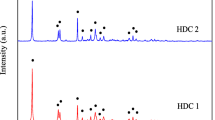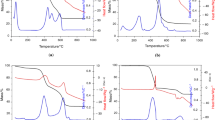Abstract
Sodium fluoride and high specific area silica were synthesized by using sodium hexafluorosilicate (Na2SiF6) and sodium carbonate decahydrate (Na2CO3·10H2O). The influencing factors of react temperature, contact time, sodium dodecyl sulfate (SDS) and molar ratio of Na2SiF6 to Na2CO3·10H2O were investigated. The optimum process involves the reaction of 0.075 mol Na2SiF6 and 150 mL, 0.225 mol Na2CO3·10H2O (molar ratio of 1:3) at 85 °C for 90 min, and 2.0×10−3 mol sodium dodecyl sulfate (SDS) as additive. The results show that the purities of SiO2 and NaF at extraction yields of 96.5% and 98.0% are 91.0% and 98.6%, respectively. The obtained SiO2 were characterized by X-ray diffraction (XRD), scanning electron microscope (SEM), Fourier transform infrared ray (FTIR), differential scanning calorimetry and thermogravimetric analysis (DSC-TGA), N2 absorption/desorption (BET) and laser particle size analyzer. The result demonstrates that SiO2 particles have a high BET surface area of 103 m2/g, and a mean grain size of 985 nm.
Similar content being viewed by others
References
LI Jin, ZUO Guang-ling, LI Ru-lin. Preparation of sodium fluoride and white carbon black from sodium flurosilicate and natural brine [J]. Inorganic Chemical Industry, 2010, 42(7): 52–54. (in Chinese)
CHEN Zao-ming, CHEN Xi-rong. Sodium fluoride production out of fluorosilicic acid solution by direct one-step process [J]. Nonferrous Metals Science and Engineering, 2011, 3(2): 32–35. (in Chinese)
ZHONG Zhao-xiang, LIU Xin, CHEN Ri-zhi, XING Wei-hong, XU Nan-ping. Adding microsized silica particles to the catalysis/ultrafiltration system catalyst: Catalyst dissolution inhibition and flux enhancement [J]. Industrial & Engineering Chemistry Research, 2009, 48(10): 4933–4938.
BANERJEE A K, LAYA M S, VEREAVEGAS W J. Silica gel in organic synthesis [J]. Russian Chemical Reviews, 2001, 70(11): 971–990.
MEYNEN V, COOL P, VANSANT E F. Verified syntheses of mesoporous materials [J]. Microporous Mesoporous Material, 2009, 125(3): 170–223.
HYO S Y, KANG R, CHURL K L, DONG H Y. Two-step ammoniation of by-product fluosilicic acid to produce high quality amorphous silica [J]. Korean Journal of Chemical Engineering, 2000, 17(4): 401–408.
ANDREZEJ K, BOZENA R, MAREK M. Silica recovery from waste obtained in hydrofluoric acid and aluminum fluoride production from fluosilicic acid [J]. Journal of Hazardous Materials, 1996, 48(1/2/3): 31–49.
SARAWADE P B, KIM J K, HILONGA A, KIM H T. Recovery of high surface area mesoporous silica from waste hexafluorosilicic acid (H2SiF6) of fertilizer industry [J]. Journal of Hazardous Materials, 2010, 173(1/2/3): 576–580.
SHI Guang-ming. A new process of sodium fluoride production by sodium carbonate decahydrate [J]. Chlor-Alkali Industry, 2009, 45(11): 29–30. (in Chinese)
ALEXANDER F I, ALLAN S M. Monentum and mass transfer in supersaturated solutions and crystal growth from solution [J]. Journal of Crystal Growth, 1997, 174(1/2/3/4): 362–368.
KALAPATHY U, PROCTOR A, SCHULTZ J. Silica xerogels from rice hull ash: Structure, density and mechanical strength as affected by gelation pH and silica concentration [J]. Journal of Chemical Technology and Biotechnology, 2000, 75(6): 464–468.
SORAPONG J. Polyethyleneimine/sodium dodecyl sulphate adsorbed silica particles and their adsorption properties [J]. Colloids and Surfaces A, 2010, 369(1/2/3): 186–190.
WANG Wei, GU Bao-hua, LIANG Li-yuan. Effect of anionic surfactants on synthesis and self-assembly of silica colloidal nanoparticles [J]. Journal of Colloid and Interface Science, 2007, 313(1): 169–173.
SAVITA R K, ANDREW P. Silica gel from rice hull ash: preparation and characterization [J]. Cereal Chemistry, 1998, 75(4): 484–487.
CHUKIN G D, IGNATEVA L A. A study of the active centers of silica gel by IR spectroscopy [J]. Journal of Applied Spectroscopy, 1968, 5(8): 527–529.
LIU Yu-rong, TU Ming-jing, ZHANG Jin, SONG Zhong-rong, TANG Ying. Synthesis of hydrophobic mesoporous silica films using poly (dimethylsiloxane)-poly (ethylene oxide) (PDMS-PEO) as co-template [J]. Microporous and Mesoporous Materials, 2011, 145(1/2/3): 182–187.
HUA Zi-le, SHI Jian-lin, WANG Lin, ZHANG Wen-hua. Preparation of mesoporous silica films on a glass slide: Surfactant template removal by solvent extraction [J]. Journal of Non-crystalline Solids, 2001, 292(1/2/3): 177–183.
WANG Li-juan, LU An-hua, WANG Chang-qiu, ZHENG Xi-sheng, ZHAO Dong-jun, LIU Rui. Nano-fibriform production of silica from natural chrysotile [J]. Journal of Colloid and Interface Science, 2006, 295(2): 436–439.
ZHURAVLEV L T. The surface chemistry of amorphous silica: Zhuravlev model [J]. Colloids and Surfaces A, 2000, 173(1/2/3): 1–38.
GORLOV Y L, GOLOVATYI V G, KONOPLYA M M, CHUIKO A A. Field desorption of water from the surface of silica and the structure of its hydrate coating [J]. Theoretical and Experimental Chemistry, 1980, 16(2): 164–168.
FRIPIAT J J, UYTTERHOEVEN J. Hydroxyl content in silica gel “aerosil” [J]. The Journal of Physical and Chemistry, 1962, 66(5): 800–805.
KISELEVI A V, UVAROV A V. Infrared spectra and electron spin resonance of aluminium, silica and titanium oxides and of adsorbed substances [J]. Surface and Science, 1967, 4(4): 399–421.
HASSAN H H, ATEIA E, DARWISH N A, HALIM S F, ABD ELAZIZ A K. Effect of filler concentration on the physic-mechanical properties of super abrasion furnace black and silica loaded styrene butadiene rubber [J]. Materials and Design, 2012, 34: 533–540.
SARAWUT P, NITTAYA R. Mechanical and damping properties of silica/nature rubber composites prepared from latex system [J]. Polymer Testing, 2011, 30(5): 515–526.
REN Xiao-dong, LIU Yue-e, PANG Gui-lin, ZHEN Wei-jun, CHEN Jin-jiang, CHANG Chao-feng. Study on preparation process of silica with wollastonite from Hami [J]. Non-Metallic Mines, 2010, 33(2): 11–14. (in Chinese)
Author information
Authors and Affiliations
Corresponding author
Rights and permissions
About this article
Cite this article
Xu, H., Li, G., Cheng, Jf. et al. Recovery of high specific area silica and sodium fluoride from sodium hexafluorosilicate. J. Cent. South Univ. 21, 4084–4090 (2014). https://doi.org/10.1007/s11771-014-2401-x
Received:
Accepted:
Published:
Issue Date:
DOI: https://doi.org/10.1007/s11771-014-2401-x




